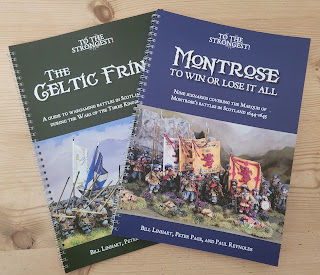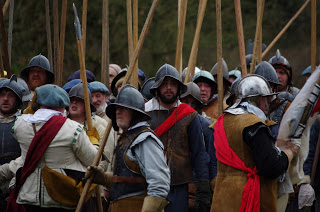Celtic Command
The current rash of 'new senior officers' continue. When will it stop? Pretty soon I'd imagine (the box of shiny things is now empty).
So here is a senior officer apiece for the The Solemn League, Montrose, and The Catholic Confederacy. These are PP figures from their 'personalities section, who have been repurposed. As with previous figures from the PP personality section, major surgery was required to remove the vast majority of their bases.
First up is John Lindsay, Earl of Crawford-Lindsay, who is the Hasselrigg figure from the range in case you are wondering. John is resplendent in full cuirassier armour.
John, born around 1598, was the eldest son of Robert, 9th Lord Lindsay, and Lady Christian Hamilton. On his father's death in1616, he became the 10th Lord Lindsay of the Byres. 1633, he was elevated to Earl of Lindsay. He also inherited the Earldom of Crawford following his cousin, Ludoivic, forfeiting the title in November 1652.
For Montrose here's Sir William Rollo (PP's Digby figure), who is sporting a secret. There are many 'command' figures available for this period waving their floppy hats in the air, very few sport secrets. In reality the majority probably would have.
And for the Catholic Confederacy, Aodh Dubh Ó Néill (PP's Goring); and no I couldn't pronounce his name either without looking it up - Audh is pronounced A (rhymes with say), Dubh is pronounced dorve, some pronounce it duff (I knew this bit).
The son of Art Og O'Neill and the nephew of Hugh O'Neill (qv), 2nd earl of Tyrone, was born in exile in the Spanish Netherlands, and like so many of his class joined the Spanish army. He served in the regiment of another uncle, Ó Néill.
In 1642 he and Eoghan Ruadh sailed with other Irish officers and men from Dunkirk to Killybegs, Co. Donegal.
Aodh Dubh was captured by English forces in Co. Monaghan in 1643 and remained in captivity until the victory of Eoghan Ruadh over the Scots at Benburb in 1646; Eoghan Ruadh traded hostages to gain the freedom of Aodh Dubh and other experienced catholic officers held captive.
Once free, Aodh Dubh was promoted to the rank of major general. After his uncle's death on 6th November 1649, Aodh Dubh put himself forward for election to the position of commander-in-chief of the Ulster army. Although he was unsuccessful, he enjoyed the confidence of the Royalist Marquess of Ormond, and in February 1650 Ormond appointed him governor of Clonmel with instructions to defend the town against the advancing forces of Oliver Cromwell.
He distinguished himself at the Siege of Clonmel: on 27th April Cromwell subjected Clonmel to a frontal attack but was kept at bay by Aodh Dubh's garrison, which held out until 9th May. On the 9th Cromwell's ordinance breached the walls, but when the New Modle Army entered through the breach they met a second line of defence, and were forced to retreat in disarray. Aodh Dubh resolved to save his troops and quit the town in the middle of the night, leaving the mayor of Clonmel to sue for peace.
On 10th May the mayor dispatched his envoys to Cromwell's camp to seek terms and quarter. Not knowing of Aodh Dubh's escape, Cromwell readily agreed, but when he found that he had been tricked he sent Lieutenant-general Edmund Ludlow and his horse in pursuit of Aodh Dubh; they caught up with the escaping column and attacked it savagely, killing 200 men, though Aodh Dubh managed to escape.
Aodh Dubh was then made commander of the defenders at the Siege of Limerick, fighting off the Parliamentarians' first attempt to take the city in late 1650.
On 27th October, weakened by hunger, plague, and the bombardment, the people of Limerick finally surrendered to Ireton; more than 5,000 inhabitants and 800 of the garrison had lost their lives during the siege. As Aodh Dubh marched out of the city with his remaining 1,200 men some of them were seen to fall dead of the plague. Ireton immediately hanged General Purcell but he spared the life of Aodh Dubh; at a council of war the next day Aodh Dubh was condemned to execution, but the death sentence was revoked on 1st November in response to his appeal on the grounds that he had only performed his duty as a soldier.
Aodh Dubh was sent to the Tower of London to await his fate, arriving there on 10th January 1652. In July the Spanish ambassador appealed for his freedom because he was a subject of the Spanish king, and claimed that his release would encourage troublesome Irish soldiers to leave Ireland and enter the Spanish service. His plea was granted, and Aodh Dubh took ship for Spain. He is last heard of in October 1660 when he wrote from Madrid to Ormond and Charles II, enquiring about his rights to the then vacant earldom of Tyrone.













Comments
Post a Comment